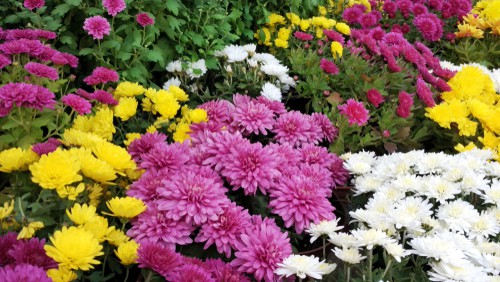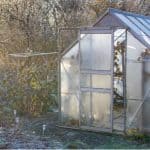Last updated on March 21st, 2022
Our site is reader supported, this means we may earn a small commission from Amazon and other affiliates when you buy through links on our site.
Chrysanthemums fall into the category of plants where the younger the growth, the better the floral production. That is why ideally you want to replace them every year and an effective way to do this is by taking new cuttings every spring instead of keeping the same plants for years and hoping their production remains as beautiful as it was the first time around, which is pretty much always never the case.
When taking Chrysanthemums cuttings, you use the same easy and very successful technique as you would with most other plants, for example, Dahlias. You can use the technique year after year assuming you keep a mother site plant, however, we recommend only keeping the mother plant for a few years before taking cuttings from a younger plant.
When to take Chrysanthemum Cuttings
Take Chrysanthemum cuttings around April when they start to shoot
If you have potted Chrysanthemums or hardy varieties in the garden, the new shoots will usually start to appear in April (depending on where you live) and this is the time you want to start taking your cuttings.
If you plan to take cuttings year after year, which is the advisable method if you want to create a substantial number of flowers, you will need to take your cuttings every April, so mark your calendar so that you don’t accidentally miss out on another year of beautiful flowers.
Taking Chrysanthemum Cuttings

Taking the cuttings
Step 1 – Preparing the plant, always take cuttings in the morning
Taking the cuttings themselves is a relatively easy process. You want to use a sharp knife, scissors or a set of bypass secateurs. Clean them and sterilise them with a mixture of one part bleach to nine parts water or use Jeyes fluid. If you are pruning more than one plant, re-dip the tools into the mixture and let them air dry in between each plant, just to ensure you do not accidentally transfer any diseases from one to another unnoticed.
Step 2 – Taking the cuttings and preparing them for planting
With that, remove some of the healthy stems that are about 10cm in length. Try to take them from the tip, but always cut away the bud at the top before you pot the cuttings. Doing this will encourage the Chrysanthemum cuttings to put their energy into the root development rather than the bud development.
Step 3 – Compost mix and pot selection
Use pots around 1 litre (13cm) in size and fill them with a compost mix, they seem to take better in a gritty mix that is well-draining so we recommend mixing about 30% grit sand with 70% seed and cutting compost. You can dip the ends of the Chrysanthemum cuttings into rooting hormone if you choose, although it is not really that necessary with these plants because they seem to root really well without it.
Step 4 – Inserting the cuttings
Take a dibber if you have one, however, a pencil or long stick will do, to make holes around the edge of the pots into which the cuttings should be placed. With these, you have a few options in terms of cover. If you have a heated propagator specifically for propagating cuttings and germinating seeds, it will likely have a bottom tray you can place the pots into, and then a plastic lid that secures in place on top. These are good as long as the cutting doesn’t come into direct contact with the lid. They will root a little faster in a propagator, especially one with bottom heat because this encourages rooting.
See some of our recommended heated propagators in this article roundup we did.
If you don’t have a propagator, another option is to just cover the pot or container with a plastic bag that is secured around the container by way of a rubber band. Again you want to be sure that the plastic bag doesn’t actually touch the cuttings, you can do this by placing some flower sticks along the perimeter to create a mini-greenhouse around the cuttings. Depending on what materials you have available you might end up using a combination of these.
Step 5 – Using heat for faster rooting and watering
You can expedite the root development by placing more containers in a propagator or placing the pots on top of a heated mat so that they absorb heat from the bottom up. The compost should be kept moist at all times. If you notice that it’s starting to dry out, obviously water more but don’t overwater because this can lead to fungal development.
Step 6 – Repotting your cuttings and hardening them off
In about four weeks the root system should establish itself so that you can pot your cuttings individually in larger containers and then place them somewhere outside to harden them off a few hours every day as long as there is no more danger of frost. It’s important to place them somewhere they receive direct light but don’t get burned by direct sunlight in the middle of the day.
Step 7 – Planting out
In the middle of May, you can plant your Chrysanthemums directly into the ground, making sure to space them approximately 20cm apart. You can benefit the plant tremendously by mixing in compost and a fertiliser such as growmore into the hole you have dug before you put your new Chrysanthemum into the ground. Once it is mixed in, backfill the hole and water it to help remove air pockets and settle the soil around the plant.
As your new cuttings are growing in the garden, you have to make a critical decision early on as to what type of production you want. You can choose between a large bushy shape with more flowers or a single, strong central stem with a bush at the top, this is also known as a standard Chrysanthemum.
Whichever you choose will determine how you should de-bud the new cutting early on. If you want just the central stem, use the same method you would apply to tomatoes, clipping away any side growth. If you want a bushy variety, cut them down from the top so that it forces more energy into producing side shoots.
Again, this is a process that you can repeat every year from the same plant so that you can enjoy the most floriferous Chrysanthemums.


